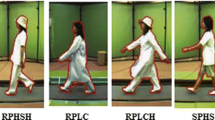Abstract
Human gait as a behavioral biometric identifier has received much attention in recent years. But there are some challenges which hinder using this biometric in real applications. One of these challenges is clothing variations which complicates the recognition process. In this paper, we propose an adaptive outlier detection method to remove the effect of clothing on silhouettes. The proposed method detects the most similar parts of probe and each gallery sample independently and uses these parts to obtain a similarity measure. Towards this end, the distances of the probe and a gallery sample are calculated row by row which are then used to obtain an adaptive threshold to determine valid and invalid rows. The average distance per valid rows is then considered as dissimilarity measure of samples. Experimental results on OU-ISIR Gait Database, the Treadmill Dataset B and CASIA Gait Database, Dataset B, show that this method efficiently detects and removes the clothing effect on silhouettes and reaches about 82 and 84% successful recognition respectively.
















Similar content being viewed by others
References
Bashir K, Xiang T, Gong S (2008) Feature selection on gait energy image for human identification. in Acoustics, Speech and Signal Processing, 2008. ICASSP 2008. IEEE Int Conf IEEE
Bashir K, Xiang T, Gong S (2010) Gait recognition without subject cooperation. Pattern Recogn Lett 31(13):2052–2060
Bobick AF, Davis JW (2001) The recognition of human movement using temporal templates. Patt Anal Mach Int, IEEE Trans 23(3):257–267
Bobick AF, Johnson AY (2001) Gait recognition using static, activity-specific parameters. in Computer Vision and Pattern Recognition. CVPR 2001. Proc IEEE Comput Soc Conf IEEE
Cunado D, Nixon MS, Carter JN (2003) Automatic extraction and description of human gait models for recognition purposes. Comput Vis Image Underst 90(1):1–41
Dockstader SL, Berg MJ, Tekalp AM (2003) Stochastic kinematic modeling and feature extraction for gait analysis. Image Proc, IEEE Trans 12(8):962–976
Guan Y, Li C-T, Hu Y (2012) Robust clothing-invariant gait recognition. Int Info Hiding Mult Sig Proc (IIH-MSP) Eighth Int Conf IEEE
Haiping LP, Konstantinos NV, Anastasios N (2008) A full-body layered deformable model for automatic model-based gait recognition. EURASIP J Adv Sign Proc
Han J, Bhanu B (2006) Individual recognition using gait energy image. Patt Anal Mach Int, IEEE Trans 28(2):316–322
Hossain A, Makihara Y, Wang J, Yagi Y (2010) Clothing-invariant gait identification using part-based clothing categorization and adaptive weight control. Pattern Recogn 43(6):2281–2291
Lam TH, Cheung KH, Liu JN (2011) Gait flow image: a silhouette-based gait representation for human identification. Pattern Recogn 44(4):973–987
Lee S, Liu Y, Collins R (2007) Shape variation-based frieze pattern for robust gait recognition. Comput Vis Patt Recog CVPR'07. IEEE Conf IEEE
Li X, CHEN Y (2013) Gait recognition based on structural gait energy image. J Comput Info Syst 9(1):121–126
Li X, Maybank SJ, Yan S, Tao D, Xu D (2008) Gait components and their application to gender recognition. Syst, Man, Cyber, Part C: Appl Rev, IEEE Trans 38(2):145–155
Liu J, Zheng N (2007) Gait history image: a novel temporal template for gait recognition. in Multimedia and Expo. IEEE Int Conf IEEE
Makihara Y, Mannami H, Tsuji A, Hossain MA, Sugiura K, Mori A, Yagi Y (2012) The OU-ISIR gait database comprising the treadmill dataset. IPSJ Trans Comput Vis Appl 4:53–62
Makihara Y, Sagawa R, Mukaigawa Y, Echigo T, Yagi Y (2006) Gait recognition using a view transformation model in the frequency domain, in Computer Vision–ECCV 2006. Springer 151–163
Piccardi M (2004) Background subtraction techniques: a review. Syst, Man Cyber IEEE Int conf IEEE
Rokanujjaman M, Hossain MA, Islam MR (2012) Effective part selection for part-based gait identification. Elect Comput Eng (ICECE) 2012 7th Int Conf
Rokanujjaman M, Hossain M, Islam M (2013) Effective part definition for gait identification using gait entropy image. Info, Elect Vis (ICIEV), Int Conf IEEE
Rokanujjaman M, Islam MS, Hossain MA, Islam MR, Makihara Y, Yagi Y (2013) Effective part-based gait identification using frequency-domain gait entropy features. Mult Tools Appl 1–22
Wang L, Ning H, Tan T, Hu W (2004) Fusion of static and dynamic body biometrics for gait recognition. Circ Syst Video Technol, IEEE Trans 14(2):149–158
Wang L, Tan T, Ning H, Hu W (2003) Silhouette analysis-based gait recognition for human identification. Patt Anal Mach Int, IEEE Trans 25(12):1505–1518
Whytock TP, Belyaev A, Robertson NM (2013) Towards Robust Gait Recognition. Adv Vis Comput. Springer 523–531
Yang X, Zhou Y, Zhang T, Shu G, Yang J (2008) Gait recognition based on dynamic region analysis. Signal Process 88(9):2350–2356
Yogarajah P, Condell JV, Prasad G (2011) P<inf>RW</inf>GEI: Poisson random walk based gait recognition. in Image and Signal Processing and Analysis (ISPA). 7th Int Symp IEEE
Yu S, Tan D, Tan T (2006) A framework for evaluating the effect of view angle, clothing and carrying condition on gait recognition. Patt Recog. ICPR 2006. 18th Int Conf IEEE
Zhang R, Vogler C, Metaxas D (2007) Human gait recognition at sagittal plane. Image Vis Comput 25(3):321–330
Zhang E, Zhao Y, Xiong W (2010) Active energy image plus 2DLPP for gait recognition. Signal Process 90(7):2295–2302
Author information
Authors and Affiliations
Corresponding author
Rights and permissions
About this article
Cite this article
Ghebleh, A., Ebrahimi Moghaddam, M. Clothing-invariant human gait recognition using an adaptive outlier detection method. Multimed Tools Appl 77, 8237–8257 (2018). https://doi.org/10.1007/s11042-017-4712-z
Received:
Revised:
Accepted:
Published:
Issue Date:
DOI: https://doi.org/10.1007/s11042-017-4712-z




